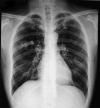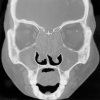Allergic aspergillosis of the respiratory tract
- PMID: 24591658
- PMCID: PMC9487274
- DOI: 10.1183/09059180.00007413
Allergic aspergillosis of the respiratory tract
Conflict of interest statement
Statement of Interest: None declared.
Figures






References
-
- Shah A. Allergic bronchopulmonary aspergillosis. Indian J Chest Dis Allied Sci 1998; 40: 41–54. - PubMed
-
- de Shazo RD, Chapin K, Swain RE. Fungal sinusitis. N Engl J Med 1997; 337: 254–259. - PubMed
-
- Shah A, Panjabi C. Allergic bronchopulmonary aspergillosis: a review of a disease with a worldwide distribution. J Asthma 2002; 39: 273–289. - PubMed
-
- Longbottom JL, Pepys J. Pulmonary aspergillosis, diagnostic and immunological significance of antigens and C-reactive substance in Aspergillus fumigatus. J Pathol Bacteriol 1964; 88: 141–151. - PubMed
Publication types
MeSH terms
Substances
LinkOut - more resources
Full Text Sources
Other Literature Sources
Medical
